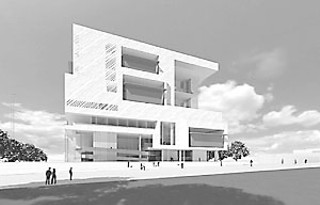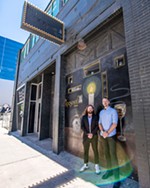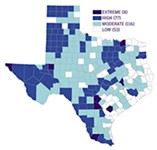All 'Round Republic Square
A new context of major civic buildings may yet make a people place of our historic downtown park
By Katherine Gregor, Fri., Sept. 1, 2006
What makes or breaks an urban park like Downtown's Republic Square Park is how well it's used by people. One of four city blocks set aside for public use in Edwin Waller's original 1839 town plan, Republic Square has endured many reincarnations over the years. (At its low point in the 1950s, it was paved over as a parking lot). A civic rally during 1999 through 2001 to redevelop the park as a more vibrant people space faded with the tech bust and 9/11, but now interest is percolating again. On three out of four sides, major new civic buildings are planned that will reframe the park: a U.S. Postal Service mixed-use development to the north, the Austin Museum of Art to the south, and the new federal courthouse to the west. The courthouse project includes a large public plaza that will flow into Republic Square, and welcome news is that Project for Public Spaces – national experts in creating successful people places – will be involved in the programming and design.
Rotating around the compass, here's a peek at the fresh context evolving for Downtown's historic town square.
WEST SIDE
Here Come the Judges
More good news: The no-Intel-inside shell across San Antonio from Republic Square will come down before the end of the year to make way for a new federal courthouse, according to the Downtown Austin Alliance (the group will host the demolition party). Deconstruction will begin right after the Oct. 5 to Nov. 5 run of a site-specific dance work, Requiem, performed by Blue Lapis Light/Sally Jacques on the five-story structure. (Dancers using ropes and bungee cords for aerial techniques, set to Mozart; more at www.bluelapislight.org)
The new federal courthouse to be built by the U.S. General Services Administration is being designed by Atlanta-based architecture firm Mack Scogin Merrill Elam Architects with local input from Larry Speck of Page Southerland Page. Unfortunately, the design is neo-brutalist – one of the least appealing styles in modern architecture. Early computer-generated design renderings show a stark, square modernist structure with fragmented forms and an exposed concrete exterior. (Rather than reflecting Austin and the park setting, the building's rectilinear concrete forms punctured by huge openings bring to mind ... the Intel shell.) The architect's project manager, John Trefay, said the GSA could release more representative images when design development is completed in November, but that the exterior has not changed significantly. Construction may not start until 2008, due to delays in federal funding.
Most transformative for Republic Square will be an expansive public plaza between the courthouse and the park. (The plaza was needed to meet security-driven setback requirements; it will replace San Antonio Street between Fourth and Fifth, which will be permanently closed). Leading the plaza design will be Hargreaves Associates. Its Park of Heroes design won the World Trade Center Site Memorial Competition; Hargreaves also is working on a network of parks for downtown Dallas.
A bright note: The GSA will pony up the funds to bring the nonprofit Project for Public Spaces into the project, thanks to lobbying by the Austin Parks Foundation, the Downtown Austin Alliance, and the Sustainable Food Center, which operates the popular Austin Farmers' Market on Saturday mornings year-round in Republic Square. A jointly signed letter sent in May resulted in the GSA committing the funds to hire PPS as project consultants. The group will hold public meetings, involve stakeholders, and help guide a design process for a plaza that succeeds as a lively, people-filled gathering space. A stellar model is the well-used Pioneer Courthouse Square in Portland, Ore., which PPS has said "sets the bar for public space programming" with its modern design, public art, amenities, plantings, walls, stairs designed to be sat upon, and built-in event venues.
Construction funds for physical improvements to the park are still lacking, however. Cousins Properties' Tim Hendricks, a longtime member of the Republic Square stakeholder group, said, "I'm hoping the feds will come to our rescue. Given the scope of their project [$60 million], it wouldn't take a whole lot more to make the improvements needed in the park." A previous Republic Square redesign, begun with Fred Kent at PPS (who called the post office the "worst design in the world to face Republic Square"), foundered and fizzled like so many other public sector projects in 2001-2002. But the elements of that design concept are still sound: removal of most berms (those big earth lumps) and the addition of colorful new plants, food kiosks, moveable tables and chairs, enhanced lighting, better electric and water access, terraced seating, improved security, and a performance stage.

NORTH SIDE
Going Postal
In early August, the U.S. Postal Service solicited redevelopment proposals for the site of the main downtown Austin post office, which occupies the full block across Fifth Street from Republic Square. With its architectural allusions to a Dollar General store in a strip shopping mall, the downtown post office was a big civic disappointment when built 10 years ago. Back then, the land was cheap (about $20 per square foot), and most of it became a parking lot; now the worth of the block is estimated by the mayor at $10 million to $15 million.
The block is important to Downtown's revitalization because – like Block 21 – it could take a high-rise unimpeded by Capitol view corridor height restrictions, historic buildings, or a protected alley. Mayor Will Wynn deservedly takes credit for working over the years to get the Postal Service to, as he says, "fix their mistake." This spring, he met with USPS representatives to again encourage redevelopment of the site, stressing its importance to the city and the community – while also pointing out that the USPS is sitting on a very valuable downtown parcel during a hot upswing in Austin's development cycle. (Nothing like the chance to cash out on real estate to suddenly motivate a self-supporting federal agency to do the right thing.)
Wynn envisions a mixed-use project with ground-floor retail that extends Austin's Great Streets program – encouraging pedestrians, vibrancy, human scale and character, and all that good urban jazz. Exactly how and whether the post office itself would be incorporated into the new development remains to be worked out; at least during construction, it would need to move to another site close by. Developer Perry Lorenz speculated that responses may be limited due to "the brain damage required" to create a project that meets exacting USPS needs and specifications. Six teams met the USPS submission deadline of Aug. 25. USPS won't release the names of the submitting teams but hopes to announce the winner by October.
(Is it too much to hope that Austin might yet get a downtown post office with a real civic presence? One thinks of the grand James A. Farley Post Office building in New York designed by McKim, Mead & White, with its famous poetic engraving, "Neither snow nor rain nor heat nor gloom of night stays these couriers from the swift completion of their appointed rounds." If our facility had an inscription, it would be a graffiti-scrawled "going postal.")
EAST SIDE
Brewskis, Condos, and Metro Males
On the east side of the park, across Guadalupe, Fox and Hound Smokehouse & Tavern will continue serving up some 70 brew choices to the big-screen-TV-sports-viewing crowd. The north end of the block already has been transformed with a new condominium high-rise, the Plaza on Republic Square ($300,000 to $1 million a unit). A street-level space facing the park, planned for a restaurant, now houses El Rey – the new $300/month private men's club, barber, and full-service salon. With any luck, El Rey will spice up Republic Square people-watching by supplying a delicious stream of mover-shaker metro males sporting really nice haircuts, manicures, and pedicures.
SOUTH SIDE
Art 'n' Condos, a Texas Two-Fer
Could the third time be charmed for the Austin Museum of Art's twice-frustrated attempt to build an architect-designed museum Downtown? Now willing to share its full-block site – also valued at $10 million to $15 million – with condos to make the project affordable, AMOA recently announced a front-runner partner for a new museum-cum-condos project: local developer T. Stacy & Associates teamed with New York architect Pelli Clarke Pelli.
The AMOA-owned block facing Republic Square across Fourth Street has exhibited naught but parked cars since a Richard Gluckman-designed museum was shelved in 2002 after fundraising efforts fell short. A museum designed in the mid-1980s by Robert Venturi's firm met a similar fate. Humbled but not defeated, AMOA now is bullish on a mixed-use project that would provide about 30,000 square feet initially for a museum (doubling the exhibition space now at AMOA-Downtown) with future expansion up to 70,000 square feet, according to museum spokesman David Wyatt.
Given AMOA's track record, observers are taking a wait-and-see approach to the project. The deal with Stacy is "still in due diligence," said Wyatt, stressing that a final development agreement with that team would be at least three to four months away, its feasibility contingent in part on the condo market. AMOA hopes to have a Stacy + Pelli project rolling forward before year-end. If the wheels fall off that deal, it would talk with other interested developer-architect teams.
Some insiders question whether the Stacy + Pelli team might be spread too thin – in May, the same developing duo announced plans for a 47-story high-rise at Fifth and Congress. Boding well for a successful project is the strong existing relationship between AMOA and developer Tom Stacy, who has been the museum's landlord at Ninth and Congress. "He's been a great landlord, very supportive of the museum, and has built a lot of goodwill with us," Wyatt said.
Another major arts group, Ballet Austin, is also contributing to a new arts and entertainment district. A renovation of its dance-education center at Third and San Antonio, will be completed next May, featuring a spiffy new façade, seven new studios, and a 287-seat theatre within a 34,000-square-foot facility. Reopening alongside it in 2007 will be the expanded Austin Music Hall.
Mexicanos, Viva Republic Park!
Interestingly, the square had early success as a lively public gathering space – achieved without benefit of consultants. From the 1870s to the 1920s, it was known as Mexican Park, because it was so popular with the Mexican immigrants who lived in surrounding neighborhoods. They built their churches around the park and used it for celebrations and socializing, just as central plazas are still used in Mexican villages. To draw attention to the Mexican-American heritage of the park, the Austin History Center hosts an annual Diez y Seis de Septiembre party (celebrating Mexico's 1810 independence from Spain) in the park each Sept. 16, with mariachi music and folkloric dancers.
After 1927, when Latinos were forced to move to East Austin, the park fell into disuse for several decades and was so devalued that it was paved for progress. It took the patriotic pride of the 1976 bicentennial celebration to make the city wake up and reclaim the historic park as a green space – and rechristen it as Republic Square. For the 1986 Texas Sesquicentennial, a private effort raised funds for the park's refurbishment, with a new landscape design by Richardson Verdoorn. (Thank its landscape architects for the funny berms.) The firm added walkways to divide the park into separate zones, symbolizing the way the Balcones Fault divides Central Texas.
Drive by Republic Square at lunchtime right now, and you're unlikely to spot any humans amid the burned-out brown grass. (True, it's 100 degrees out, but can't the city budget stretch to keep the place watered?) For a livelier scene, stop by on a Saturday morning for the Austin Farmers' Market. Over the past few years, public use has steadily improved, thanks to efforts by the Austin Parks Foundation, the Downtown Austin Alliance, Austin Parks & Recreation, and other partners. The park hosts Movies in the Park, Yoga in the Park, and even wireless Internet. Now, with the promise of a new plaza and people-packed perimeter, Republic Square could once again become the lively town square provided 170 years ago. Lunch alfresco, anyone? ![]()
Got something to say on the subject? Send a letter to the editor.











